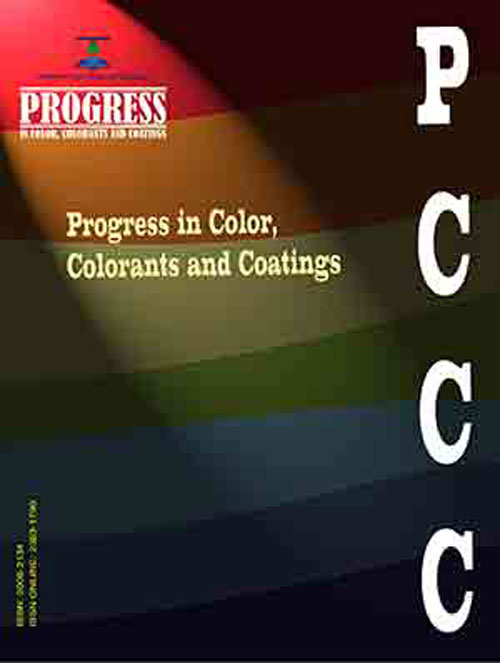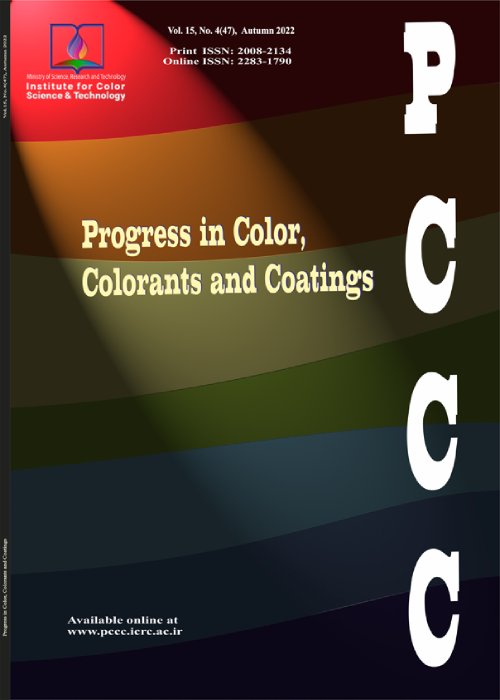فهرست مطالب

Progress in Color, Colorants and Coatings
Volume:9 Issue: 2, Spring 2016
- تاریخ انتشار: 1395/03/26
- تعداد عناوین: 6
-
-
Pages 77-83Ion implantation is a surface modification technology that produces new materials on the surface by impingement of high energy ions from the ion accelerator. In this work, AISI 304 stainless steels were coated with 90 nm Ni film by electron beam deposition and implanted by a flow of 5×1017 N−2 at 400 K with different implantation energies of 10, 20, 30 and 40 keV. The corrosion behavior of prepared samples was tested in 3.5% NaCl solution using potentiodynamic polarization technique. Crystallographic and morphological structure of the samples was analyzed by X-ray diffraction (XRD) and scanning electron microscope (SEM), respectively. A clear correlation was achieved between the physical analyses (XRD and SEM) and the potentiodynamic results. The highest corrosion resistance was achieved with a corrosion current density of 0.172 µA cm-2 in the case of sample which was N ion implanted at 20 keV. Prog. Color Colorants Coat. 9 (2016), 77-83 © Institute for Color Science and Technology.Keywords: Ni thin films, Corrosion, Potentiodynamic, Stainless steel, SEM
-
Pages 85-97In this paper¡ dye removal ability of the surface modified nanoparticle (SMN) (copper ferrite) using surfactant(cethyl trimethyl amonium bromide (CTAB)) from single and quaternary systems was investigated. Acid Blue 92 (AB92)¡ Direct Green 6 (DG6)¡ Direct Red 23 (DR23) and Direct Red 80 (DR80) were used as model compounds. The effect of surfactant concentration¡ adsorbent dosage¡ dye concentration and pH on dye removal was evaluated. The adsorption isotherm and kinetic were also studied. The maximum dye adsorption capacity (Q0) was 178.571 mg/g AB92¡ 49.261 mg/g DG6¡ 39.841 mg/g DR23 and 43.290 mg/g DR80 for SMN. It was found that dye adsorption onto SMN followed Langmuir isotherm. Adsorption kinetic of dyes was found to conform to pseudo-second order kinetics. Prog. Color Colorants Coat. 9 (2016)¡ 85-97 © Institute for Color Science and Technology.Keywords: Quaternary system, Dye removal, Surface modified nanoparticle, Isotherm, Kinetic
-
Pages 99-108Chemical and biological treatment of dye- containing wastewaters is difficult due to the low adsorption level and chemical stability of dyes. Activated carbon is usually used for adsorption of these materials¡ but because of high prices and restore problems¡ researchers trying to find available low-cost materials with high adsorption. In this study¡ bagasse was used for adsorption of Remzol Black B dye and its capability was examined. Variables were concentration¡ temperature¡ pH and contact time¡ and the degree of adsorption was examined in different situations. Then¡ adsorption isotherm according to Langmuir and Freundlich models was investigated. The results showed that the adsorption efficiency depends more on pH of solution and less on temperature of the solution. Maximum adsorption of Remzol Black B dye by bagasse occurred in the first 15 minutes of contact. The study of adsorption isotherm showed that both models are suitable for description of adsorption of Remzol Black B dye by bagasse. Maximum adsorption of Remzol Black B dye by bagasse was calculated as 7.51 mg/g. Results of this study showed that bagasse could be used as a low-cost bio adsorbent for the adsorption of Remzol Black B from aqueous solution. Prog. Color Colorants Coat. 9 (2016)¡ 99-108 © Institute for Color Science and Technology.Keywords: Adsorption_Adsorption Isotherm_Bagasse_Remzol Black B Dye
-
Pages 109-116porous composite of cerium oxide and gamma aluminum oxide pigments was prepared via sol-gel processing controlled within reverse micelles of nonionic surfactant Triton X-114 in cyclohexane. The precursor was heated at several calcination temperatures between 823-1123K. This process includes three steps. In the first step of preparation the ceria sol was prepared. In the second step¡ cyclohexane was mixed with surfactant¡ distilled water and ceria sol. At last¡ gamma nano aluminum oxide was fluently injected into the mixture. The micellar ceria/γ-alumina sol precursor with different molar ratios was mechanically stirred to form a homogeneous suspension. The mixture was washed with ethanol. The effect of different molar ratios of Ce:Al on the crystallization was also studied. X-ray diffraction (XRD) analysis¡ transmission electron microscopy (TEM)¡ scanning electron microscopy (SEM)¡ temperature programmed reduction (TPR) technique and N2 adsorption/desorption isotherm revealed that crystalline nanosized pigments are obtained. The produced pigments possess mesoporosity with pore diameters mainly distributed between 20 to 45 nm. Surface area increases by increasing the calcination temperature. Also¡ the particle size of the pigments decreases with increasing the Ce:Al molar ratio. Prog. Color Colorants Coat. 9 (2016)¡Keywords: Nanocomposite, Reverse micelle, Calcination temperature, Molar ratio, Cerium oxide, Aluminum oxide
-
Pages 117-134he inhibitive effect of apricot gum (AG) on mild steel in 0.5 M phosphoric acid solution was investigated by potentiodynamic polarization, electrochemical impedance spectroscopy (EIS), linear polarization resistance and electrochemical noise (EN) techniques. The inhibition efficiency increased with AG concentration up to a certain value and decreased with increasing temperature. Polarization curves indicated that AG acts as a mixed type inhibitor. The EN data were analyzed by statistical and wavelet methods. The results obtained from analysis of EN data was in good agreement with those achieved by the polarization and EIS measurements. The adsorption of the inhibitor on the alloy surface in 0.5 M H3PO4 followed the Langmuir isotherm. According to the calculated values of both free energy and enthalpy of adsorption, it was revealed that the adsorption of inhibitor on the steel surface was a combination of physical and chemical adsorption. The morphologies of the uninhibited and inhibited mild steel surfaces in 0.5 M H3PO4 which were analyzed by scanning electron microscope (SEM) showed that the alloy surface damage is significantly decreased due to the presence of inhibitor. Prog. Color Colorants Coat. 9 (2016).Keywords: Apricot gum, Electrochemical, impedance, spectroscopy (EIS), Electrochemical noise resistance, Phosphoric acid, Green inhibitor, Wavelet analysis
-
Pages 135-143This work describes the photocatalytic removal of methylene blue from aqueous solution by titanium dioxide nanoparticles under ultraviolet irradiation in a batch system. The effect of operational parameters such as irradiation time, nano titanium dioxide dosage, pH and initial methylene blue concentration were analyzed and optimized by response surface methodology in the nano titanium dioxide/ultraviolet irradiation process. As results, the predicted values were best fitted with the experimental data (R2 = 0.9736). The maximum removal efficiency was in the following conditions: irradiation time of 31.5 min, nano titanium dioxide dosage of 1.19 g L-1, pH of 7.8 and initial methylene blue concentration of 4.5 mg L-1. Under the optimized status, the removal yield was obtained more than 80%. Carrying out the experiment under this optimum condition resulted in the same removal efficiency, which indicated the success and suitability of the central composite design model for the optimization of the process. Prog. Color Colorants Coat. 9 (2016).Keywords: Methylene blue, Nano, TiO2, Optimization, Photocatalyst, Response surface methodology


